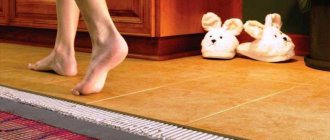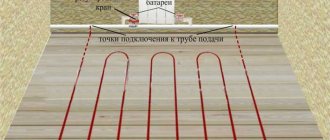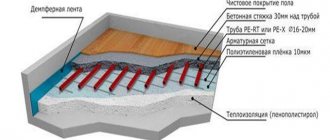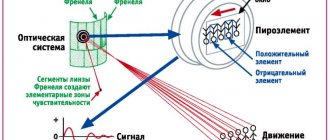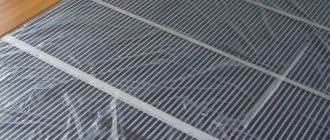To create the most comfortable living conditions, apartment owners most often give preference to a heated floor system. This design allows for more uniform heating. At the same time, the temperature is distributed vertically in such a way that the air in the area of the legs is as warm as possible, and closer to the head it is cooler. Of course, these systems are not without drawbacks. And the main one is the high price. This article will tell you which is better, radiators or heated floors, and which is the cheapest heated floor.
Conventional radiators or heated floors
The question of what is better to install, radiators or heated floors, is asked by most owners who decide to equip a heating system. The choice is actually not easy. Therefore, it is worth considering all the advantages and disadvantages of radiator heating and underfloor heating.
To understand whether heated floors or radiators are better, you should compare the systems according to the following characteristics:
- Price. The price is influenced by many factors. Therefore, there is no point in naming specific numbers. But, nevertheless, it will be much more expensive to equip a warm water or electric floor than a radiator system. Installation of electrically heated floors is of course cheaper than their water counterparts, but they are more expensive to operate.
- Economical to use. In this regard, conventional batteries are inferior to heated floors. Most often, radiators are installed under windows. This leads to a lot of heat escaping through the outer wall and windows. A heated floor uses much less energy to create a comfortable temperature in the room. Over the entire heating season, you can save up to 20% with a heated floor system.
- Final coating. When using a heated floor structure, restrictions arise regarding the choice of finishing coating. After all, some materials do not transmit heat well, when heated they can release toxic substances and wear out faster.
- Maintainability. Conventional radiator systems are much easier to repair. Because they are in plain sight. But if it is necessary to replace the elements of the heated floor, you will have to dismantle the finishing coating and screed.
- Inertia. Heated floors have greater inertia than radiators. By adjusting the heating temperature of heated floors, the result can be felt within 30 minutes. But in the case of traditional radiator heating, you will have to wait several hours. Therefore, when thinking about whether warm floors or heating radiators are better, you can give preference to the first option.
- Interior. In this regard, warm floors are, of course, better. After all, the structure is hidden under the floor. This means it does not spoil the appearance of the room. Batteries sometimes do not fit into the interior; they have to be disguised.
- Drafts. The heated floor wins here. With its use, there will be practically no drafts in the apartment.
Thus, what is better - warm floors or radiators, of course, is up to the owner of the house to decide. But heated floors are still a more worthy and modern choice at the moment. It is especially recommended to install such a system in corridors, sanitary facilities, garages, bathhouses, and utility rooms.
You can use heated floors in combination with radiator heating. In this way, it is possible to create a flexible and soft microclimate in the apartment.
Of course, the price of a heated floor under a carpet is considerable. Therefore, due to a lack of financial resources, some owners have to opt for standard heating using batteries.
How to reduce energy consumption
There are two approaches to the issue of reducing consumption while maintaining a comfortable microclimate in the house. First of all, energy savings should be taken care of at the stage of design, calculations and installation of heated floors. This will allow you to know in advance how much energy the heated floor consumes.
Energy consumption is influenced by factors such as high-quality insulation of buildings. Modern heat-insulating materials and technologies for their installation make it possible to get rid of 30-40% of total heat loss. And this means a reduction in energy consumption.
The next method is the principle of reasonable sufficiency. There is no point in installing a powerful heating element where the heat demand is small. To do this, you need to evaluate the heat losses of each room and the required power to compensate for them. Using underfloor heating with a lower power density will maintain comfort and save energy. Reducing the indoor temperature by just 1°C can save up to 5% of consumption.
When using underfloor heating as additional heating, you need to properly plan its placement. Warming the spaces under beds, furniture walls, stationary massive sofas, bathtubs and showers does not add comfort to residents, but only wastes energy inefficiently. Heating elements should only be placed on walkways and where people will touch the floor.
The use of high-quality thermal insulation under a heated floor allows you to save a lot of heat and electricity. Heating efficiency also depends on the presence of a thermally reflective layer, which reflects infrared rays from the thermal insulation back upward, towards the floor. If a cement screed is used, it is necessary to carefully insulate it from walls and other building structures to prevent the occurrence of so-called “cold bridges”, which will become a path for heat leakage.
High-quality thermal insulation of the house will help reduce the energy consumption of underfloor heating
It is equally important to manage available capacity wisely. Conventional thermostats allow you to maintain a constant temperature in the room. And if you use programmable controllers, you can save up to 40% by temporarily lowering the temperature while there are no people in the room. If you combine all the regulators and heaters into the Smart Home system, you won’t have to waste time programming each device - their operating mode can be set from a computer or smartphone and control the heating of the house from afar.
When using the system as the main heating, it makes sense to install a two-tariff electricity meter. And run the system at full power at night, when kilowatt-hours are cheaper. And during the day, when residents go to work and study, reduce the power and temperature in the rooms.
Types of heated floors
It is clear that heated floors are today the best solution for providing high-quality and efficient heating. But what kind of heated floors there are, and which type is more economical, remains to be figured out.
The following heated floors are distinguished:
- Mermen. Heating is implemented as follows: a line is laid in the floor through which heated liquid circulates. The system is quite expensive and labor-intensive to install. But during operation it does not require large capital investments. To create the most economical water-type heated floor, you can use polypropylene pipes. They are much cheaper than copper or metal-plastic ones. True, the durability of polypropylene is lower. It is also important to remember that equipment for a water system requires special permission from the housing office. You will probably need to install a separate riser. And this is an additional waste, and a considerable one.
- Electrical. Structurally, heated floors are simple. Installation is quick and easy. Heating cables or infrared film are laid and the final coating is mounted on top. In addition, the price of cable heated floors is lower than its water counterpart. But in operation, an electrically heated floor is not cheap. A square meter consumes about 100 W per hour.
Factors affecting energy consumption of underfloor heating
With proper installation and calculation, you can heat your house efficiently and not overpay
Electricity is an expensive source of energy, but effective. If you choose the right heating system, you can keep your home warm without spending a lot of money on bills.
System type
There are several types of floor electric heaters:
- Heating cable – resistive or zonal. The cheapest option. Accumulates a certain amount of heat; after switching off, the floor cools down slowly. The installation scheme is complex: the cable can only be placed in open areas, otherwise it will overheat and fail. This modification is installed on balconies, loggias, and in bathtubs, where heating is required less frequently.
- Thermal mats – convection and infrared. More economical and consume less electricity. Installation requires high qualifications. Thermal mats are placed under a thin floor covering, placed in a screed or in a layer of tile adhesive.
- IR film – heating only due to IR radiation. In this case, the stage of heat transfer to the coating disappears. IR film is more effective. It is installed in residential areas where an acceptable temperature must be maintained at all times.
- Self-regulating - due to the inclusion of carbon-polymer material, the system is self-regulating. In a cold section of the cable, the resistance drops, a higher intensity current passes through it and heats it up. When heated, the resistance of the cable increases and the current weakens. This option is designed for the industrial sector, expensive to manufacture, but more efficient than other modifications.
External factors
Electricity consumption is affected by the area of windows and doors, their number
Factors determine the amount of heat loss. The smaller they are, the less powerful the heating can be installed, and the less you pay for electricity. Consider the following:
- Number of windows and doors - metal or glass surfaces conduct heat well. Prevent losses by insulating doors.
- Level of resistance to heat loss - the value is determined by the wall material - brick, concrete, quality, thickness of the thermal insulation layer, characteristics of external and internal finishing. Insufficient thermal insulation negates the benefits of underfloor heating and leads to unnecessary costs.
- Weather conditions – during extreme cold, consumption naturally increases.
- Number of residents - the more people live in the apartment, the less the heated floor works.
Floor characteristics
The wider the laying step, the lower the energy consumption
The energy consumption of any underfloor heating option is influenced by its own indicators:
- the presence of a thermostat - the more accurately the temperature is controlled, the more economical the system is;
- cable laying step - the smaller it is, the more powerful the heater, the more energy it consumes;
- the thickness of the flooring - laminate, tiles, or screed - the smaller it is, the lower the electricity consumption.
Carpet or rugs reduce the efficiency of the underfloor heater and cause it to work too hard. The material makes it difficult to dissipate heat, which can lead to overheating and damage to the cable. Only small decorative rugs are allowed.
Which underfloor heating is the most economical?
The answer to the question of which heated floor is the most economical depends on the type of room and operating conditions. For example, it will be more profitable for owners of private houses to install a water system. The costs of its purchase and installation quickly pay off. But for residents of city apartments, electric heated floors would be preferable. This option will be much cheaper and easier to install than installing a water system.
It should also be noted that the high price per m2 of electric-type underfloor heating prompted developers to create an infrared film system. The design is distinguished by the fact that it transfers heat over the entire surface. With cable options, heat is concentrated in certain areas. Therefore, the infrared design allows you to heat the room much faster, while reducing energy costs.
When choosing the type of heated floor, you need to think about the type of floor covering.
For example, the best option is ceramic tiles. This material has a fairly high thermal conductivity. Laminate and parquet transfer heat a little worse. But carpets have the lowest thermal conductivity. When asked which heated floor under a parquet board is better, many experts recommend the water type.
For economical operation, experts recommend installing a Unibox temperature controller. This unit allows you to significantly reduce energy costs. Of course, the price of a Unibox for heated floors is high, but the purchase of this unit and its installation is justified and quickly pays off.
The reliability and durability of a structure largely depends on its details. The most important component of heated floors is the comb. Its main task is to organize the work of the entire system. Therefore, it is not worth saving on this element. Moreover, the price of a comb for heated floors is quite affordable. The cost depends on the number of circuits. For example, a comb for a heated floor with 5 circuits costs about 23,000 rubles, and a comb assembly with 3 circuits will cost 21,000 rubles.
Nominal and real energy consumption of electric heated floors
Main types of electric floors
To determine the power consumption of a heated floor, you should consider the basic power of each type of material used during installation. The most common types are:
- film infrared coating;
- heating cable;
- thermomat
Classification of warm electric floors
For thin flooring, such as laminate or linoleum, film heating systems are most often used. For tiles and other hard materials - cable or mats. Film coating consumes the most electricity, heating cable is the most economical. Thermal mats are based on an infrared blanket, so their energy consumption indicators are similar to film ones.
Basic power of heating devices
The electricity consumption of each heating system depends on a set of characteristics:
- material thickness;
- power of devices per 1 sq. meter;
- maximum heating temperature.
Table of heat consumption of heated floors in rooms
The manufacturer is required to indicate this data on the original packaging of the material, as well as the nominal amount of energy consumed.
Table of power consumption of some models of heating elements per 1 sq. meter:
The cable has a small power, but it is placed in several turns per 1 sq. meter, so that the total power of the heated floor is 130–150 W per square meter - this is the average.
Power calculation for heated floors
Factors affecting power consumption
Total costs for underfloor heating systems
But there are other factors that can reduce or increase electricity consumption, these include:
- the level of thermal insulation of the walls in the room - the higher it is, the lower the energy consumption will be;
- outside air temperature - in the cold season, the electric floor will work much more;
Energy consumption calculation
In order to calculate how much electricity a heated floor will consume, there are several approaches:
Calculation of nominal consumption: in a room with an area of 14 m2, heating elements will occupy 10 m2. To calculate electricity consumption, you need to multiply the coverage area by the power.
Electricity consumption of infrared heated floors
Let's assume that a thermomat with a power of 130 W per 1 meter² is used, then 10*130 = 1300 W or 1.3 kW/h is the nominal consumption. Further, we assume that the floor is turned on for 8 hours per day, then per day it turns out - 8 * 1.3 = 10.4, and per month - 10.4 * 30 = 312 kW.
The average cost of 1 kW in Russia is 2.5 rubles, so the cost of operating a heated floor will be 780 rubles. This method makes it possible to calculate the maximum amount of energy consumption, without taking into account the use of a thermostat and other factors affecting consumption.
Technology for calculating costs using a coefficient.
The formula used for calculation is: W=S*P*k, where:
Graph of heating and electricity consumption of infrared heated floors
S – room area;
P – heating element power;
k is the coefficient of useful heating area, according to generally accepted standards it is equal to 0.4.
A room with an area of 20 m2, a thermomat with a power of 130 W per 1 meter² is used, then the formula will be as follows:
W= 20*130*0.4 = 1040 W (1.04 kW).
Next, we calculate the electricity consumption per day: 8 hours * 1.04 kW = 8.32, per month - 12 * 30 = 249.60 kW. Cost of expenses – 249.60*2.5 = 624 rubles.
Electricity consumption of infrared film
How different are the actual energy consumption figures from the nominal ones?
Of course, the actual consumption will be very different from the nominal values, since it often happens that there is no one in the house all day and there is no point in turning on the floor, so in reality it will only work for 5 hours. There will also be no need for daily heating, especially in warm autumn, late spring and summer, so the calculated figures will be approximately two times lower.
Correct installation of electric heated floors
There are also ways to significantly reduce power consumption, for example, using a thermostat. A good device will save up to 30% of the nominal energy consumption. In practice, it turns out that the electric floor heats up to the set temperature in 5 minutes, then cools down for 10 minutes and turns on again. The heating element only works for 20 minutes per hour. If the entire system is turned on for 9 hours a day, only 3 hours of which electricity is consumed, therefore the costs will look like this:
W= 20*130*0.4 = 1040 W/h (1.04 kW);
1.5*3 = 3.12 – per day;
3.12*30 = 93.60 – per month;
93.60*2.5 = 234 rubles.
There are several other ways to reduce energy consumption:
Review of economical models
Today, manufacturers offer a wide range of different types of heated floors, different models. On average, the cost of a heated floor costs 2000-5000 rubles per square meter. Of course, it all depends on the brand and model. For example, mobile heated floors are quite affordable - about 5000-6000 rubles. They look like a small rug. It is very easy to install and dismantle. Simply spread it out and plug it in. Installation of a water floor costs approximately 1,850 rubles per square meter. Installation of infrared and cable structures is cheaper - 700-900 rubles.
As for the most popular manufacturers, we can name such brands as Rexva, Aura, Teplolux, Devi, Spyheat, Equation, Energy, Nexans.
Rexva
Rexva products have been known to domestic manufacturers since 2005. Film floors from this company are distinguished by their energy-saving effect. The systems allow you to save up to 40% of energy. Rexva heated floor consumes from 35 to 100 W/sq.m. This is quite enough to ensure the most comfortable heating of the room.
Aura
The products of the German company Aura are also quite well known. The company specializes in cable heating systems. Innovative developments and modern equipment are used in production. Thanks to this, Aura warm floors are of high quality and durability. The manufacturer guarantees that the device will operate without failure for more than 20 years. The average price of an Aura heated floor is about 1,400 rubles. It should be noted that the company also produces thermostats.
Teplolux
Many owners highly appreciate the products of the Teplolux company. The systems from this company are very easy to install. Because no screed is required. Laying is done directly under the floor covering. The floor level remains virtually unchanged. Heating is uniform. In addition, the price for Teplolux underfloor heating is quite reasonable - about 1,200 rubles. Using a thermostat allows you to save up to 70% of electricity.
Devi
The Devi company specializes in the production of cable heated floors. An important element of the Devi system is the Devireg thermostat. It is capable of automatically determining the time when heating is turned on and off. There is also an autonomous power supply. Equipped with a design and a child protection system. On average, the price for Devi heated floors is affordable. This allows you to save a lot of money on your purchase. And thermostats provide savings during operation.
Spyheat
Spyheat underfloor heating has also proven itself well, as it is fully adapted to domestic energy supply specifications. The product can be used under any type of floor covering. The company specializes in the production of heating mats and cable floors. The price of a heated floor from this manufacturer is from 2,400 rubles.
Equation
Good reviews of Equation underfloor heating are the deciding factor in making a purchase for many owners. The products of this company are highly reliable and safe. In addition, the cable floor is moisture resistant.
Energy
Energy heating systems have been in increasing demand lately. The main advantages of this product include uniform heating, saving space in the room, and durability. When considering Energy underfloor heating for installation, the company’s official website will help you find out more detailed information about the systems of this manufacturer.
Nexans
Warm floors from Nexans are also very economical. The thermostat allows you to significantly reduce energy costs. The system is multifunctional. You can install Nexans warm floor under any covering. The product goes well with carpet, linoleum, parquet, wood, laminate, and tiles. Installation is very simple and does not require professional skills.
Warm floors today are the most modern and efficient heating structures.
But the cost of purchasing and installing them is slightly higher than installing batteries. True, during operation you can achieve good savings. Therefore, many people have a question about which heated floor is cheaper. It all depends on the type of room: for a dacha, a water floor is more suitable, and for a city apartment, an electric heated floor is more suitable. You can also reduce operating costs by using thermostats.
How to calculate electricity consumption
To independently determine how much energy an electric heated floor consumes, you must use the following formula:
W=S*P*0.4, where
S – area of the room;
P—system power;
0.4 is a coefficient that takes into account how much of the floor surface in the room is covered with cable/film. In other words, 0.4*S is the useful heating area.
Let's say, for example, we need to calculate the electricity consumption of an electric heated floor with a power of 150 W/m2 in a living room with an area of 25 m2.
Then, our formula will take the following form:
W=25*150*0.4=1500 W, which means a consumption of 1.5 kW per hour.
This means that we know the hourly consumption, but that’s not all.
As a rule, the heating system operates 8-9 hours a day when all residents are at home. In total, electricity consumption per day will be approximately 12-13.5 kilowatts. It turns out that the monthly electricity consumption of the “warm floor” will be about 360-400 kW.
Let us take into account that the above calculations are very rough, and the actual consumption is 2 times less. This is due to the fact that thermostats should be installed, which save energy by approximately 40%.
Next, we multiply the power that the system consumes per month by the cost of one kilowatt of energy at the time of calculation
In total, you will get the finished energy consumption of the system, on the basis of which you can analyze whether such heating is profitable or not
Next, we multiply the power that the system consumes per month by the cost of one kilowatt of energy at the time of calculation. In total, you will get the finished energy consumption of the system, on the basis of which you can analyze whether such heating is profitable or not.
The calculation formula is quite simple. Using this technology, you can easily calculate the energy consumption of underfloor heating in any room: bedroom, kitchen, bathroom and even on the balcony, the main thing is to have a calculator at hand!
We saw how much electricity a heated floor consumes. If you make the calculation for all rooms, you will get a decent amount “for light”. Of course, when you pay the first receipt, you will think about how you can reduce costs and make your heating system economical.
However, we will give a few tips that will significantly reduce the electricity consumption of underfloor heating in the house:
1. Take care of high-quality insulation of the house. It was experimentally determined that good thermal insulation reduces energy consumption by 35-40%.
2. Be sure to install the thermostat on the wall at the coldest point in the room. Thus, the heating will turn on when the temperature drops below the set one, and, conversely, turn off when the room is sufficiently heated. Temperature controllers, as we have already said, can reduce up to 40% of electricity consumption.
3. Install a multi-tariff electricity meter in your house, at which the electricity tariff at night is 1.5-2 times lower (depending on the region). All the same, the electric heated floor will work in your presence, and this is just in the evening when you come home from work. So why pay more?
4. Lay material only in the usable area. You should not install it under furniture and household appliances; this is not advisable from the point of view of reducing consumption and, moreover, is prohibited by the manufacturers of heating materials themselves.
5. You can sacrifice a little heating by lowering the room temperature by just 1 degree. A small donation can reduce the energy consumption of an electric heated floor by as much as 5%!
Let's watch a video on this topic:
Calculation example
To calculate how much a heated floor consumes, you need to:
- Determine the active area of the floor heating system.
- Multiply it by the power per square meter indicated in the passport.
The result is the maximum possible energy consumption. However, the floor will consume so much kW/h only if it is turned on at full speed and without adjusting the thermostat. But in reality, the electric TP system operates for 5–20 minutes per hour. And actual consumption will be several times less.
Electricity consumption chart
There is nothing complicated in these calculations. Figuring out why a gas boiler goes out or how to connect the boiler is often more difficult. With a heated floor, everything is simpler.
With a heating area of 12 m2 and a TP power of 150 W/m2, we obtain a nominal consumption for the room of 1.8 kW/hour. But in fact, such a heating floor will consume about 0.3 kW for every hour of use. It will heat for 10 minutes and then cool for 50 minutes. However, a lot here depends on the temperature outside the window and the thermostat settings.
Comparison of different heating systems
Saving tips
There are several ways to save energy:
- Insulate the room or building you want to heat with warm floors; with high-quality thermal insulation, consumption can be reduced by 30-40%.
- Buy a thermostat, or better yet, a programmable thermostat (flow comparison is shown in the graph below).
Comparison of energy consumption, consumption is indicated per day for 9 hours heating - Lay only under free space, do not lay it under furniture and appliances.
- When the temperature in the house decreases by 1°C, the consumption will again decrease by about 5%.
Water floor
The photo shows water heated floor pipes laid in polystyrene foam mats.
A water heating system is a system of pipes through which hot water flows. The main feature of such a system is that it is inappropriate to use in small areas. It is better to refrain from installing it in an apartment, but for a private house, a water-heated floor will be an excellent addition to the overall heating system. In the first case (use in apartment buildings), hydraulic resistance and coolant temperature losses increase. But even in a low-rise room there is one negative point: when connecting the floors to the hot water supply system, the pressure decreases, which requires the installation of a circulation pump, proper installation and configuration of the entire system by a professional, in order to avoid mistakes.
Installation of a water heated floor is impossible without a concrete screed. It can withstand heavy loads created by the pipeline. In addition, the contact of the pipes with the screed creates a single heating surface.
The pipes themselves must be resistant to corrosion and adverse environments, and must also have low sound conductivity.
A water underfloor heating system has a number of advantages:
- Despite the costs of materials, components and installation, in the future such a system will save 15% on electricity compared to electric floors;
- During installation, you can not take into account the location of the furniture on the floor surface;
- Fire safety;
- Long service life;
- Can be used at any time of the year. And in the summer, in extreme heat, you can let the pipes run empty, thereby cooling the room;
- Ability to operate from any heating system. This includes a gas boiler, a heat pump, and a solar collector.
If you use this underfloor heating system, you can adjust the heating mode and microclimate, taking into account weather conditions.
Costs of funds for the purchase of equipment and materials, installation and operation of underfloor heating systems. As you can see, water heated floors, despite the high initial investment, are more economical in the long run than electric systems




